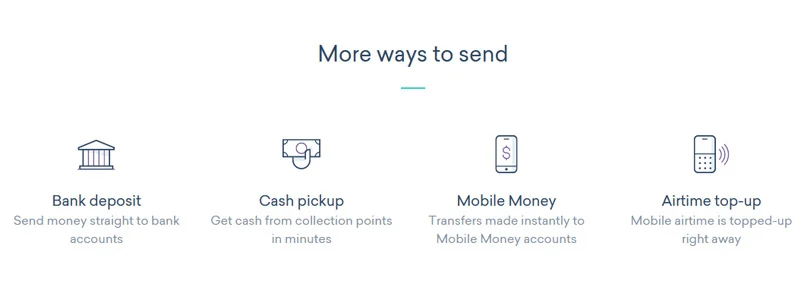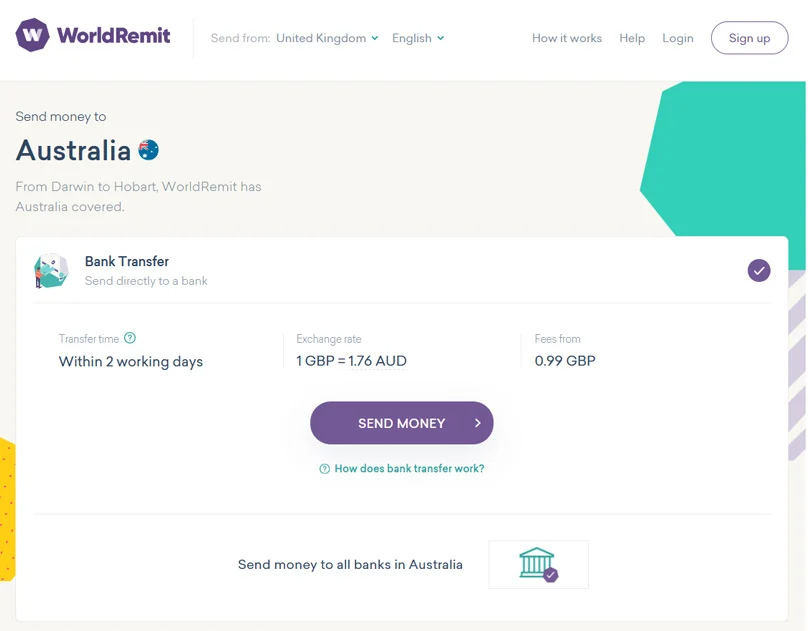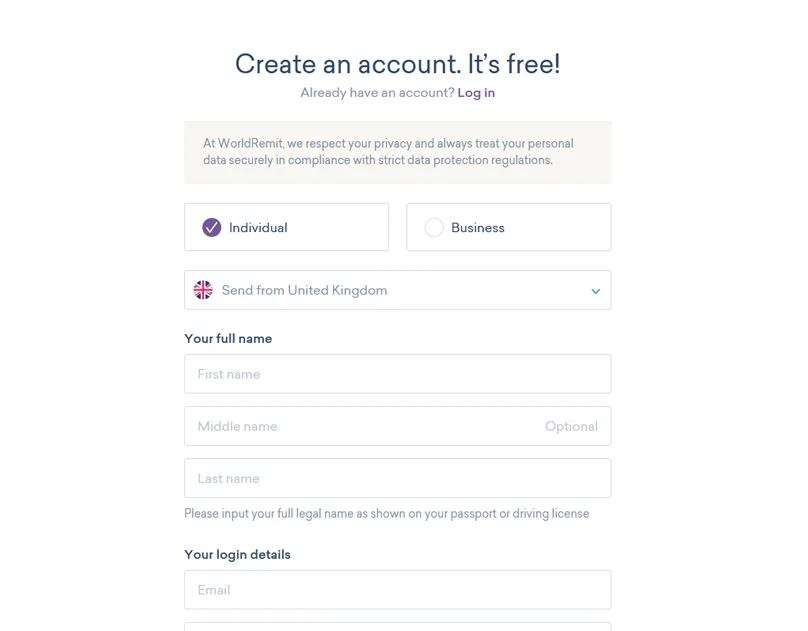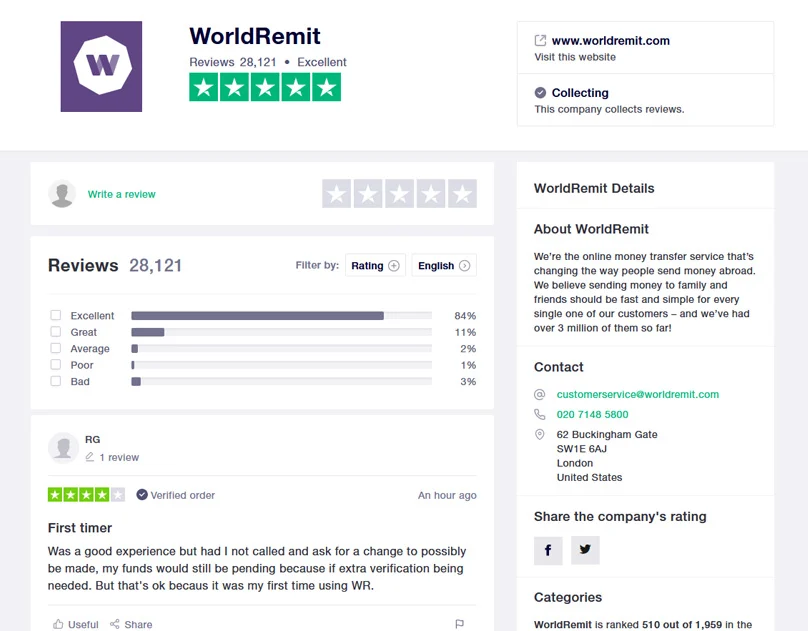Whether you send money abroad frequently, or simply need to perform a one-time international transfer, you’ll want to keep your costs as low as possible. The days of Western Union and MoneyGram dominating this space are soon dwindling, as there are now a number of alternative providers that not only offer significantly cheaper rates but faster transfer times, too.
One such organization that claims to offer “a better way to send money” abroad is World Remit. The platform allows you to send money overseas at the click of a button via your bank account. In some cases, you can even use your debit or credit card.
If you’re thinking about using World Remit for your international money transfer needs, then we would suggest reading our comprehensive review. We’ve covered everything from how the platform works, fees, payment methods, transfer times, and more.
Let’s start by exploring who World Remit actually is.
Who is World Remit?
Launched in 2010 by Ismail Ahmed, World Remit is a money transfer service that allows you to seamlessly send money overseas via its online platform. The company was formed with the view of reducing the highly expensive fees charged by legacy transfer service firms like Western Union.
Based in London, World Remit also has office locations in the U.S., Poland, and the Philippines. Its international network of banking providers spans over 150 countries, subsequently allowing people to send and receive money with ease.
Since the company was formed in 2010, World Remit has serviced over 4 million customers, across more than 90 individual currencies. According to the World Remit team themselves, 90% of the international transfers they facilitate are completed within minutes.
Moreover, 70% of mobile transfers average a transaction processing time of just 3 minutes. Although we will explore this in more detail further down, this makes World Remit significantly faster than traditional kiosk-based or high street bank transfers.

However, it is important to note that on top of bank-to-bank transfers, World Remit also offers cash pick-ups and mobile-to-mobile payments in certain countries. This is ideal for those that need to send money to friends or family based overseas that don’t have access to everyday banking services.
As an organization that operates in the UK, World Remit is authorized and regulated by the Financial Conduct Authority (FCA). This ensures that World Remit has your best interests at heart and that you have a stringent regulatory oversight keeping tabs on the company at all times.
So now that you have a better idea of who World Remit is, in the next part of our review we are going to explore how the platform works.
How Does World Remit Work?
In order to facilitate super fast international transfers, World Remit has an extensive banking network in multiple countries. Not only does this result in fast transfers, but by operating in multiple currencies, transfers are cheaper, too. This is because, unlike traditional money transfer providers, World Remit partners already hold the currency that you want to transact in.
When it comes to paying for your transfer, you have a number of options available to you. If opting for a bank transfer, you will need to transfer the funds directly into the specific account details provided by World Remit. They then forward the cash onto the receiver via their international network of partnered banks.
Alternatively, you can also pay for your transfer by using your debit or credit card, or even a pre-paid card. If this doesn’t suffice, then World Remit also accepts Apple Pay, Android Pay, and Sofort.
Before you make the payment, you will be presented with all of the necessary information related to your transfer. This will include transfer fees, exchange rates, and the estimated transfer time. The rates you are offered are only valid for 24 hours, so you need to make sure you transfer the funds within this timeframe.
Once World Remit receives your payment, they will then instruct their partnered financial institution to forward the money to the beneficiary. This is completely different from using a traditional bank to send money abroad, as typically, they will use the SWIFT network. This is not only expensive, but it usually takes 3 days for the funds to arrive.
So now that you know how the World Remit payment system works, let’s take a look at how the money is actually received by the beneficiary.
How Does the Receiver get Their Money?
While paying for your World Remit transfer needs to be done online, you get to choose from a number of different options when it comes to how the beneficiary receives the money. The options available to you will depend on where you are based, as well as where the receiver is based. Nevertheless, we’ve listed the different options below.

Bank-to-Bank
The most common transfer option is to send the money to the receiver’s bank account. This option is available in over 150 different countries. You will need to make sure that you have access to all of the relevant banking details for the person you want to transfer the funds to, such as the bank name, IBAN number, and SWIFT code.
As soon as the bank transfer has been completed, the receiver will have the funds deposited directly into the account you specified.
Cash Pick-ups
If the person you want to send money to doesn’t have a bank account, or the receiver is based in a country where World Remit doesn’t have a banking partner, then you might need to consider a cash pick-up.
This means that the receiver will need to visit a supported World Remit partnered location and collect physical cash. Each supported country will have its own partner agreements, so you will need to check the World Remit website to see where the receiver needs to go.
For example, while Cambodia’s cash pick-ups are limited to just WING locations, Indonesia is supported by the Post Office, Bank Negara, and Bank Rakyat.
Much like in the case of Western Union or MoneyGram, the receiver will need to display a government-issued ID before the funds are handed over, as well as the World Remit transaction ID.
Mobile Transfers
Although not as popular in the UK, a good number of countries based in third world regions now rely heavily on mobile payments. For example, it is estimated that the mobile payments sector in Kenya is now worth the equivalent of half of the country’s GDP.
When you send funds to the receiver in the form of mobile payment, the beneficiary will be able to purchase goods and services at a number of partnered locations. All they need to do is show the vendor their mobile wallet, which is then either scanned or transferred directly on the spot. Before you execute a mobile payment via World Remit, you first need to ensure that the receiver is set up with a supported mobile wallet.
If they are, the deposit process works in the same way as any other payment method offered by World Remit. All you will need to provide is the receiver’s mobile phone number.
Now that we’ve covered the various manners in which the beneficiary can receive their funds, in the next section of our World Remit review we are going to unravel the platform’s fees.
What Fees do World Remit Charge?
Attempting to understand how much you are actually paying when transferring money is no easy feat. Regardless of who you use to facilitate the transfer, you need to consider fees on a number of fronts. Mainly, this centers on the transfer fee itself, as well as the currency exchange rates used.
A slight drawback to using World Remit is that the fee structure can vary quite considerably. In fact, the easiest way to determine how much you are likely to pay is to enter the details of the transfer through the website.
Factors such as where you are sending the money from, where the beneficiary is based, how much you are sending, the currencies involved, and the payment method used, can also have an impact on how much you pay.
Therefore, the only way to assess the fees charged by World Remit is to look at some real-world examples.
Example 1: Sending £500 from the UK to Costa Rica.
In the case of sending money to Costa Rica, the only option available to the receiver is to collect the cash in person. If you were to send £500, you would pay a total fee of £6.99, which is added to the transfer amount.
On top of this, you would also need to factor in the exchange rate used. With an inter-bank and World Remit GBP/CRC rate of 729.91 and 716.07, respectively, this would amount to a foreign exchange fee of 1.93%.
Example 2: Sending £500 from the UK to Australia.
If you were to send £500 to Australia on a bank-to-bank basis, then you would pay a transfer fee of just £0.99, which is excellent value. In terms of the foreign exchange fee, this amounts to just over 0.6%, which again, is a great value.

Example 3: Sending £500 from the UK to India
If you were to send £500 to India, then the only option available would be a bank transfer. World Remit will charge you a flat fee of just £1.99 per transfer. Even better, the exchange rate utilized by World Remit amounts to just 0.59%, which is much lower than the likes of Western Union, MoneyGram, or a traditional high street bank.
All in all, the transfer fees charged by World Remit are highly competitive.
Payment Fees
On top of the transfer fees imposed by World Remit, you also need to consider whether or not you will be charged to make a payment. From the perspective of World Remit themselves, you will not be charged anything to make a payment – regardless of the payment method you opt for.
However, there might be an odd occasion where the payment issuer charges you. For example, if using a credit card to pay for the transfer, then your credit card issuer might charge you an additional fee. This is because the transfer is likely to be viewed as a cash advance, and thus, this might cost in the region of 3%.
Furthermore, if you are using a debit/credit card issued by a bank outside of the country you are sending the transfer from (for example using an Australian debit card in the UK), then you might be charged a foreign transaction fee.
Ultimately, this is out of the hands of World Remit, so you will need to clarify this before making the payment.
How Long do World Remit Transfers Take?
Much like in the case of the transfer fee structure, transfer times with World Remit can vary wildly. Notably, this will depend on the type of payment method you use, how the beneficiary will receive the funds, and the country you are sending the money.
In terms of cash pick-ups and mobile payments, these are typically the fastest transfer type. In fact, the vast majority of payments will be processed within a few minutes.
On the other hand, bank transfers are usually slower. This will depend on the location of the receiver’s bank, and even the day/time of the transfer. For example, if you were to perform a bank transfer to somebody in India, the beneficiary will typically receive this on the same working day. However, sending funds to Australia usually takes around two days.
Once again, the only way to ascertain how long the transfer will take is to enter the details of the transfer through the World Remit website.
How Do I Get Started With World Remit?
In order to use World Remit to send money overseas, you will first need to register an account via the company’s online platform. As the company is fully regulated by the FCA, you will need to go through a basic KYC (know-your-customer) process.
This ensures that you are who you say you are and that the company is able to verify your identity. As such, you will need to provide a range of personal information. This will include your full name, address, date of birth, nationality, and contact number. In order to satisfy World Remit’s regulatory obligations, you will also need to submit some identity documents.

This will include a government-issued ID such as your passport or driver’s license, as well as proof of address. World Remit will accept a telephone or utility bill, council tax bill, or bank statement. Take note, that your proof of address cannot be older than 6 months.
As soon as your identity has been verified, you can then proceed to make a transfer. You will initially need to enter the country that you want to send the funds to, alongside the amount. You will then need to select how the beneficiary is to receive the funds from the drop-down box.
Once you click on the ‘Send’ button, you will then be shown a breakdown of the costs. This includes the flat transfer fee, as well as the foreign exchange rate used. If you’re happy with the fees, simply follow the on-screen instructions to make your payment.
When everything has been processed, you will be able to keep tabs on the transfer through your World Remit account.
Customer Service and Reviews
If you need to contact the team at World Remit, you have two options. The fastest way is to call the team directly. Not all locations have a local toll number available, so do bear this in mind.
Alternatively, you can send the support team a direct message through your online account portal. Unfortunately, there is no live chat facility.
In terms of reviews available in the public domain, World Remit has a very good reputation. For example, the platform has a 5/5 rating score of ‘Excellent’ on TrustPilot, which is based on almost 28,000 individual reviews.

World Remit Review: The Verdict?
In summary, World Remit is an excellent option if you are looking to transfer money to friends and family based overseas. Whether it’s on a bank-to-bank, cash pick-up, or mobile payment basis, the fees are extremely competitive. We also like the fact that the exchange rates utilized by World Remit are also very competitive, with the spread often less than 1%.
On the other hand, it would be nice if World Remit were a bit more consistent with its transfer fee structure. The only way to actually find out how much you will be paying is to enter the details of the transfer via the World Remit website. On the other hand, we appreciate that each country, payment method, and currency will have its own fees attached it, which is why the costs can vary.
Ultimately, World Remit is a much more viable option than using the likes of Western Union or MoneyGram. Not only is the platform cheaper, but in most cases, faster.


